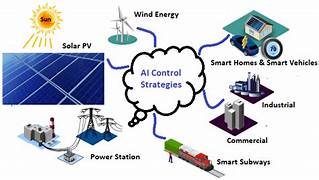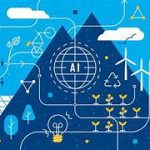AI-Driven Optimization of Renewable Energy Grid Distribution
Introduction
As the world shifts towards renewable energy sources such as solar and wind power, one of the biggest challenges is ensuring efficient distribution across energy grids. Unlike traditional fossil fuel-based energy systems, renewable sources are intermittent and unpredictable, making grid management complex. Artificial intelligence (AI) is playing a transformative role in optimizing renewable energy grid distribution by predicting supply and demand, enhancing grid stability, and improving energy efficiency. This article explores how AI is revolutionizing renewable energy distribution and its impact on sustainability and energy security.
Challenges in Renewable Energy Grid Distribution
Renewable energy grids face several challenges, including:
- Intermittency: Solar and wind energy depend on weather conditions, leading to fluctuations in power generation.
- Demand-Supply Mismatch: Energy demand patterns do not always align with when renewable sources generate the most power.
- Grid Stability Issues: Sudden surges or drops in power generation can strain the grid and lead to blackouts.
- Storage Limitations: Current battery storage technologies are expensive and limited in capacity.
AI-driven solutions are helping to tackle these issues, making renewable energy distribution more reliable and efficient.
How AI Optimizes Renewable Energy Grid Distribution
AI integrates machine learning algorithms, predictive analytics, and automation to manage energy distribution effectively. The key AI applications in renewable grid optimization include:
1. Forecasting Energy Supply and Demand
AI algorithms analyze historical data, weather patterns, and real-time inputs to accurately predict energy generation and consumption trends. This helps:
- Energy providers optimize grid operations based on expected fluctuations.
- Reduce energy wastage by aligning generation with demand.
- Improve energy trading by predicting price variations in real-time.
2. Smart Grid Management
AI enables smart grids, which use sensors, IoT devices, and AI algorithms to monitor and control energy flow dynamically. Smart grids:
- Automatically adjust energy distribution based on real-time conditions.
- Balance supply and demand efficiently to prevent power shortages.
- Reduce transmission losses by routing power through optimal pathways.
3. Grid Load Balancing and Stability
AI-driven systems help prevent grid overloads by:
- Identifying congestion points and rerouting electricity to less-stressed areas.
- Optimizing frequency regulation to maintain grid stability.
- Reducing reliance on backup fossil-fuel power plants by efficiently managing energy sources.
4. AI-Powered Energy Storage Optimization
Energy storage plays a crucial role in mitigating the variability of renewable energy. AI enhances storage solutions by:
- Predicting when to charge or discharge batteries to maximize efficiency.
- Integrating multiple storage technologies, such as lithium-ion batteries and pumped hydro storage, based on real-time grid needs.
- Reducing operational costs by optimizing energy storage cycles.
5. Decentralized Energy Management with AI
AI supports decentralized energy grids by managing energy from multiple distributed sources, including rooftop solar panels and community wind farms. This results in:
- Increased energy resilience by reducing dependence on centralized power plants.
- Efficient peer-to-peer energy trading, where excess energy can be sold to neighboring users.
- Smarter integration of small-scale renewable energy producers into the grid.
Benefits of AI in Renewable Energy Grid Optimization
AI-driven optimization offers several advantages:
1. Improved Energy Efficiency
By predicting demand and supply accurately, AI reduces energy losses and maximizes the use of renewable resources.
2. Enhanced Grid Reliability
AI helps maintain stable voltage levels and prevents blackouts, ensuring continuous energy supply even during fluctuations in renewable energy generation.
3. Cost Savings for Consumers and Utilities
AI-driven energy management reduces operational costs, leading to lower electricity bills for consumers and higher profitability for energy providers.
4. Greater Integration of Renewables
With AI handling the complexities of energy distribution, more renewable energy sources can be integrated into the grid without compromising stability.
Challenges of AI in Renewable Grid Optimization
Despite its benefits, AI implementation in renewable energy grids faces certain challenges:
1. Data Availability and Accuracy
AI models require large amounts of high-quality data from energy providers, weather agencies, and smart meters. Inconsistent or insufficient data can reduce prediction accuracy.
2. Cybersecurity Risks
As energy grids become more digitalized, they become vulnerable to cyber threats. AI systems must be equipped with robust security measures to prevent hacking and data breaches.
3. High Implementation Costs
Integrating AI with renewable energy grids requires investment in advanced infrastructure, IoT sensors, and cloud computing, which can be expensive.
4. Regulatory and Policy Barriers
Energy regulations in different regions may limit the adoption of AI-driven solutions, requiring government and industry collaboration to develop supportive policies.
Future of AI in Renewable Energy Distribution
The future of AI in renewable energy grid management looks promising, with ongoing advancements in:
- AI-Driven Microgrids: Small, localized energy grids that can operate independently or connect to the main grid.
- AI-Powered Blockchain Energy Trading: Secure and transparent energy transactions between consumers and producers.
- Autonomous Energy Systems: AI-enabled systems that automatically optimize energy flows without human intervention.
- Integration with Electric Vehicles (EVs): AI can manage EV charging stations, optimizing when and where vehicles charge to balance the grid efficiently.
Conclusion
AI-driven optimization is revolutionizing renewable energy grid distribution, addressing key challenges such as intermittency, demand-supply mismatches, and grid stability. By leveraging AI technologies, energy providers can improve efficiency, reduce costs, and accelerate the global transition to renewable energy. Despite existing challenges, ongoing technological advancements and supportive policies will further enhance AI’s role in creating a sustainable and resilient energy future.


